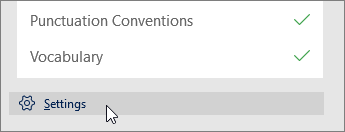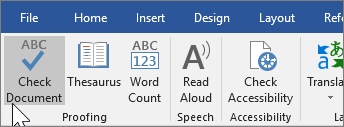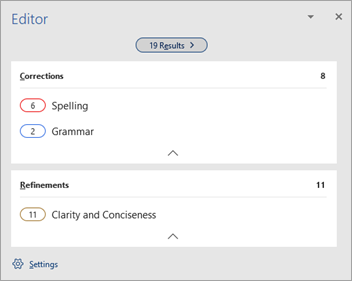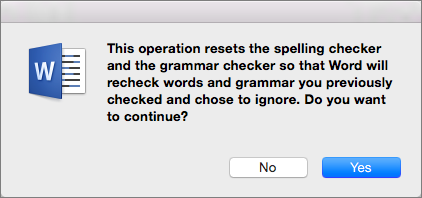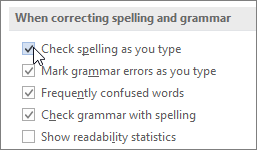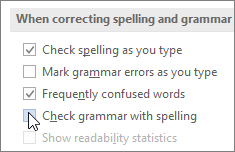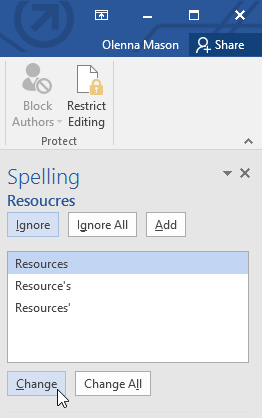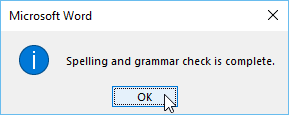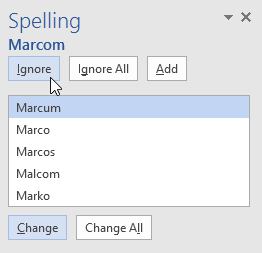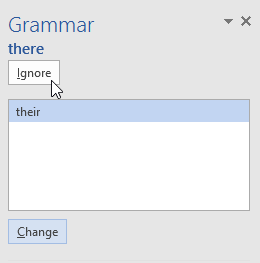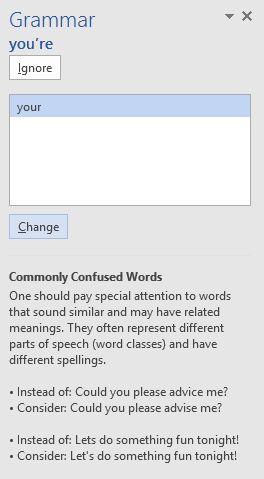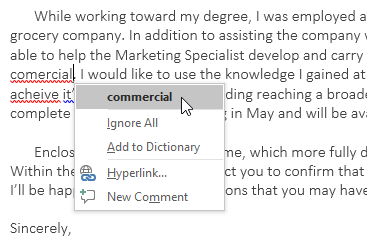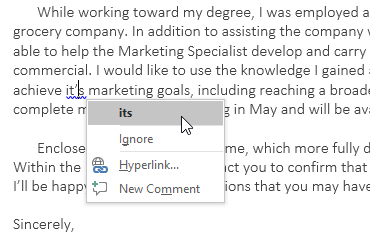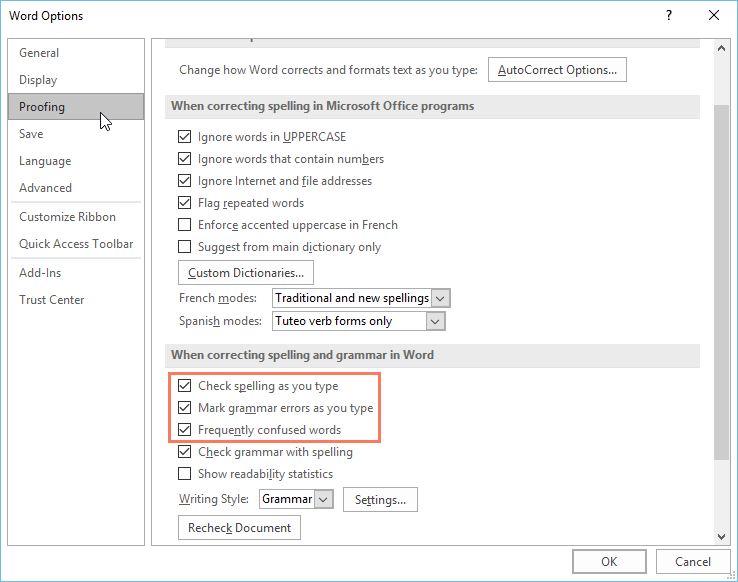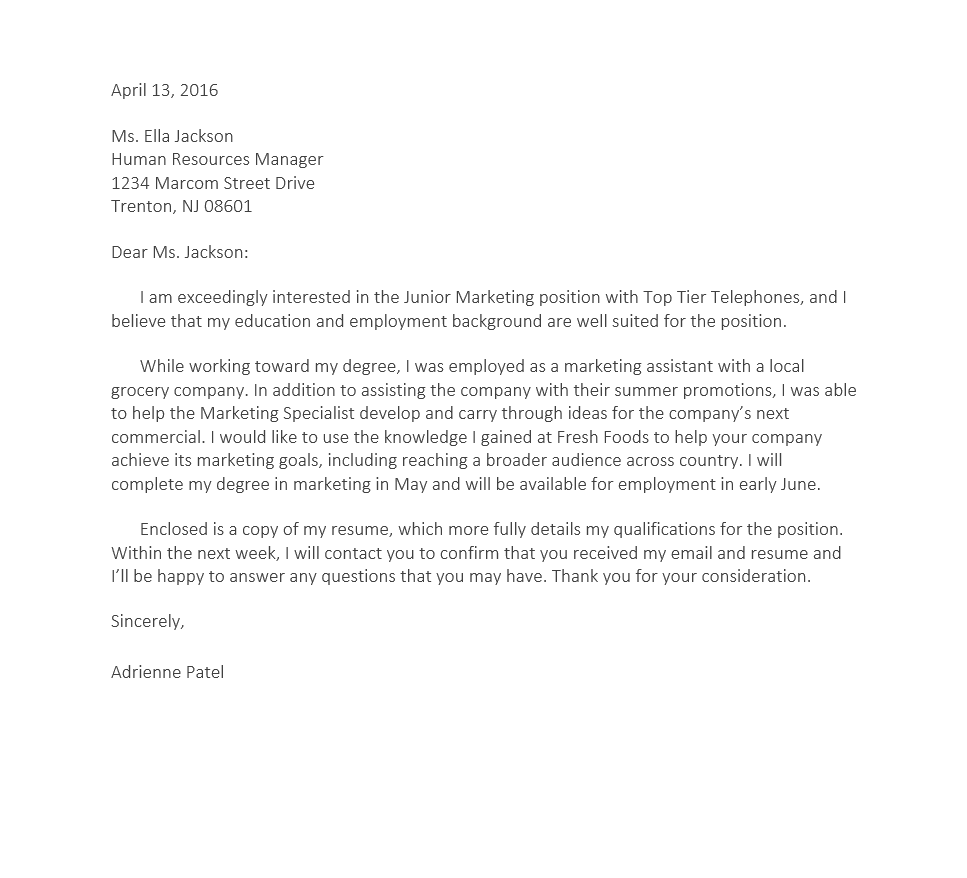Microsoft Editor runs in Word for Microsoft 365 to analyze your document and offer suggestions for spelling, grammar, and stylistic issues, like making sentences more concise, choosing simpler words, or writing with more formality.
To use Editor, on the Home tab choose Editor.
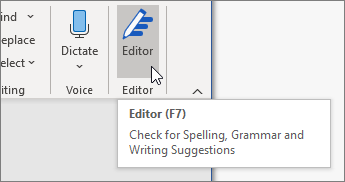
Reviewing suggestions
To focus on the issues you care most about, choose a correction or refinement type, like Grammar or Clarity. Then, use the arrows near the top of the pane to step through each of that type of issue.
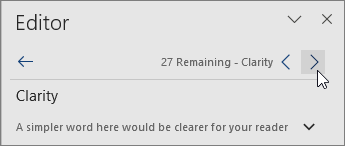
Choose a suggestion to incorporate it into your document. If you don’t like the suggestion, choose Ignore Once. Or, if you never want this type of suggestion, choose Don’t check for this issue.
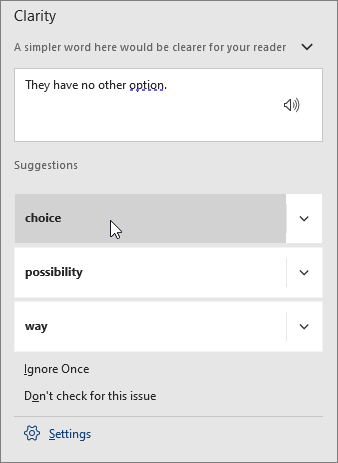
Note: If you change your mind about an issue you ignored, close and reopen the document, and go back to Editor. Editor will find the issue again.
Tailor what Editor checks for
By default, Editor checks for several categories of issues, and the suggestions may or may not suit your writing style. To finely tune Editor for suggestions you want, do the following:
-
In the Editor pane, choose Settings.
-
In the Word Options dialog box, next to Grammar & Refinements, choose Settings.
-
Scroll through the list of options. Select issues you want Editor to check, and clear the issues you want Editor to ignore.
Note: Choosing Reset All returns to the default settings.
-
Choose OK.
Tip: Editor is designed to empower you to bring out the best in your writing. We are continually making updates to its suggestions and experimenting to learn which suggestions are most welcome. If you have feedback for us, choose Help Improve Office? at the top of the Word window to open the Feedback pane.
You might notice Editor’s red, blue, and purple underlines in your document even when the Editor pane is closed. That’s because Editor is always running in the background, checking for spelling, grammar, and some style issues.
Right-click the underlined text to see the suggestion. Use context menu to:
-
Listen to the suggestion by clicking the arrow next to the suggestion and then choosing Read Aloud.
-
Skip this instance of the issue by choosing Ignore Once.
-
Tell Editor to stop checking for this issue by choosing Don’t check for this issue.
-
Fine tune the settings for this type of issue by choosing the Options link.
-
Get more information about the issue by choosing See More.
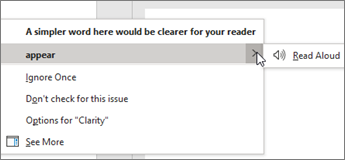
Your document might be written in more than one language, or you might want to switch to another language for Editor to check. If you are set up to use multiple authoring languages (File > Options > Language), Word detects the language you’re writing in, and Editor will check for issues in that language.
However, you might be writing in a language that Word doesn’t detect automatically. In that case, you can get Editor to check text in that language by selecting the text and going to Review > Language > Set Proofing Language, and then choose your language.
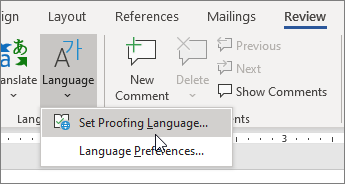
When Editor is checking more than one language, the Editor pane lists corrections and refinements for each language in the document.
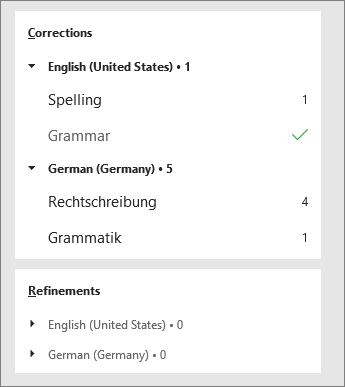
For information about the issues that Editor checks in various languages, see Editor’s spelling, grammar, and refinement availability by language.
When you work on documents in Word on the web, Editor provides a rich set of features that are coming soon to Word for Windows. Even when you’re not using Word, the Editor browser extension helps you with writing on websites like LinkedIn, Twitter, Facebook, and Gmail.
Word marks spelling, grammar, and stylistic issues with an underline. Right-click the underlined word, and then choose the suggestion you want, or learn more about the error and how to correct it.
Or, open the Editor pane to address issues by category.
-
On the Review tab, select Check Document.
-
The Editor pane categorizes spelling, grammar, and stylistic issues.
-
Click each category to address the issues.
Note: For keyboard shortcuts in the Editor pane, there’s no need to press Alt. Just use the underlined letter to select the command (like i for Ignore Once, g for Ignore All, etc) .
-
In the Editor pane, click Settings.
-
Under When correcting spelling and grammar in Word, select Settings
-
For Writing Style, select Grammar & Refinements .
-
Scroll down to see all of the options available, and select or clear the rules you want. The settings apply to all the documents that you edit, not just the current one.
Requirements and availability of the Editor pane include the following:
-
Internet connection: Make sure your connection is working.
-
Intelligent Services switched on: Go to File > Options > General and turn on Office Intelligence Services.
-
Language availability: For information about the issues that Word checks for in various languages, see Editor’s spelling, grammar, and refinement availability by language.
Word marks spelling, grammar, and stylistic issues with an underline. Control-click the word or phrase and choose one of the options.
If Word incorrectly underlined a word as misspelled and you want to add that word to your dictionary so that Word will properly recognize it in the future, see Add or edit words in a spell check dictionary.
If spelling or grammatical errors aren’t underlined, you might need to turn on automatic spelling and grammar checking, as follows.
Turn on (or off) automatic spelling and grammar checking
-
On the Word menu, click Preferences > Spelling & Grammar.
-
In the Spelling & Grammar dialog box, under Spelling, check or clear the Check spelling as you type box.
-
Under Grammar, check or clear the Check grammar as you type box.
-
Close the dialog box to save your changes.
-
On the Review tab, click Spelling & Grammar.
-
Word displays the issues it finds in the Spelling & Grammar dialog box.
-
To address an issue, do one of the following:
-
Type the correction in the box and then click Change.
-
Under Suggestions, click the word you want to use, and then click Change.
To skip the error, do one of the following:
-
Click Ignore Once to skip only that instance of the error.
-
Click Ignore All to skip all instances of the error.
-
For a grammatical error, click Next Sentence to skip that instance of the error and move to the next error.
To skip a misspelled word in all documents, click Add to add it to the dictionary. This only works for spelling. You can’t add custom grammar to the dictionary.
-
-
After you correct, ignore, or skip an issue, Word moves to the next one. When Word finishes reviewing the document, you’ll see a message that the spelling and grammar check is complete.
-
Click OK to return to your document.
You can clear or reset the list of Ignored Words and Grammar so Word will check for spelling and grammar issues you previously told it to ignore.
Note: When you reset the list of Ignored Words and Grammar, the list is cleared only for the currently open document. Any spelling or grammar issues you told Word to ignore in other documents won’t be affected.
-
Open the document that needs to be checked.
-
On the Tools menu, point to Spelling and Grammar, and then click Reset Ignored Words and Grammar.
Word displays a warning about the operation resetting the spelling checker and the grammar checker.
-
Click Yes to proceed.
-
Click the Review tab, and then click Spelling & Grammar to check spelling and grammar.
Word marks potential spelling errors with a red squiggly line, and potential grammatical errors are marked with a blue squiggly line.
Right-click on the underlined word or phrase and choose a correction, or ignore the suggestion.
Note: If Word is flagging words as misspelled but you have it spelled the way you want it, select Add to Dictionary to teach Word not to flag that word as misspelled in the future. For more information on this see: Add or edit words in a spell check dictionary.
If you don’t want Office to mark potential errors with squiggly lines while you are working, you can turn automatic spelling and grammar checking off:
-
On the File menu, click Options, and then click Proofing.
-
Select or clear the Check spelling as you type and Mark grammar errors as you type check boxes.
Note: You can turn the spelling checker on or off for the document you’re working with or for all new documents. Select an option in the Exceptions for list, and then select or clear the Hide spelling errors in this document only and Hide grammar errors in this document only check boxes.
If you don’t want Word to check grammar at all (either when running a spell check or automatically as you type), you can turn it off:
-
On the File menu, click Options, and then click Proofing.
-
Clear the Mark grammar errors as you type and Check grammar with spelling check boxes.
-
On the File menu, click Options > Proofing> Recheck Document.
-
Click Yes when you see the warning message about resetting the spelling and grammar checker.
-
Click OK in the dialog box to get back to the document, and then run the spelling and grammar checker again.
See also
For more information about Microsoft Editor, see Microsoft Editor checks grammar and more in documents, mail, and the web.
For more topics on spelling and grammar, see Spelling and grammar in Word.
To try Microsoft Editor for yourself, download the Editor in Word Tutorial.
Check spelling and grammar all at once On the Review tab, click Spelling & Grammar. If Word finds a potential error, the Spelling & Grammar dialog box will open, spelling errors will be shown as red text, and grammatical errors will be shown as green text.
Contents
- 1 How do you check Grammar errors in Word 2010?
- 2 Does Microsoft Word have a Grammar checker?
- 3 How do you check Grammar and punctuation in Word?
- 4 How do I check grammar in Word 2007?
- 5 How do I check accuracy in Word?
- 6 Does Office 365 have spell check?
- 7 How do I check in a Word document?
- 8 How can I check if my punctuation is correct?
- 9 How do I turn on Track Changes in Word?
- 10 How do I change my grammar settings in Word?
- 11 Why is spell check not working in Word 2007?
- 12 Which key is used for spelling and grammar check?
- 13 Is Word’s spelling and grammar check is always 100 accurate?
- 14 What is proofing in Microsoft Word?
- 15 Why is my Word document not showing spelling errors?
- 16 How do I add grammar check in Outlook 365?
- 17 How do you check grammar in Outlook?
- 18 Is spell check one word?
- 19 How do I check a checkbox in Word?
- 20 How do I insert a checkmark in Word?
How do you check Grammar errors in Word 2010?
More videos on YouTube
- Go to the Review tab.
- Click on the Spelling & Grammar command. The Spelling & Grammar command.
- The Spelling and Grammar dialog box will open. For each error in your document, Word will try to offer one or more suggestions.
- If no suggestions are given, you can manually type the correct spelling.
Does Microsoft Word have a Grammar checker?
Microsoft Word comes with a powerful grammar checker, but many of its advanced grammar detection features are disabled by default. Grammarly is popular, but you don’t need it to add grammar checking to Word. Word itself contains a free alternative to Grammarly.
How do you check Grammar and punctuation in Word?
Use the spell-check tool to check for correct punctuation in Microsoft Word. Find it by pressing F7 (on Windows), clicking the small book icon along the bottom edge of the screen, or clicking on “Spelling & Grammar” under the Review tab.
How do I check grammar in Word 2007?
You can also grammar check a document after you are finished typing. From the Tools menu, select Spelling and Grammar… Press [Option]+[Command]+[L]. The Spelling and Grammar dialog box appears.
How do I check accuracy in Word?
Get your document’s readability and level statistics
- Go to File > Options.
- Select Proofing.
- Under When correcting spelling and grammar in Word, make sure the Check grammar with spelling check box is selected.
- Select Show readability statistics.
- Go to Home > Editor.
Does Office 365 have spell check?
Office 365 (Outlook for Windows) – Check spelling before sending a message. You can check the spelling in your email message at any time by clicking Review > Spelling & Grammar when composing or replying to a message. If you don’t want to do check spelling manually for every message—or you’re worried you might forget
How do I check in a Word document?
If you can’t find the checkmark icon in the Symbol drop-down menu, do the following:
- Click More Symbols…
- Click the “Font” text field.
- Type in wingdings 2 and press ↵ Enter .
- Scroll down until you find the checkmark, then click it.
- Click Insert.
How can I check if my punctuation is correct?
Here’s how to use this tool:
- Type or Copy (CTRL+C) & Paste (CTRL+V) the text in the Editor.
- Click the Lookup button.
- Spelling, Grammar, and Punctuation mistakes will be underlined.
- Hover your mouse cursor on each word for correct Options.
- Use The Deep Lookup button for a thorough check through our partner grammar check.
How do I turn on Track Changes in Word?
Turn tracked changes on or off
- Open the document that you want to edit.
- On the Review tab, under Tracking, select the Track Changes switch to turn on track changes. Tips: Each reviewer’s changes are displayed in a different color. If there are more than eight reviewers, Word will reuses colors.
How do I change my grammar settings in Word?
Follow these steps:
- Open the Spelling & Grammar dialog. Go to Word > Preferences… > Spelling & Grammar.
- Go to Writing Style Settings. On Writing style: Grammar, click Settings…. The Grammar Settings dialog opens.
- Choose Your Grammar and Style Options. Check or uncheck items under Grammar and style options.
Why is spell check not working in Word 2007?
Solution 1: Verify the “check spelling as you type” feature is on.In the Spelling and Grammar: dialog, click the Settings link in the Editor pane. In the Word Options dialog, check the boxes for Check spelling as you type and Mark grammar errors as you type. Click OK.
Which key is used for spelling and grammar check?
F7
Check and correct the spelling and grammar
Open the document you want to check for spelling or grammar mistakes, and then press F7. You can also use the ribbon to start the check. Press Alt+R to open the Review tab, and then press C, 1 to select the Check Document option.
Is Word’s spelling and grammar check is always 100 accurate?
Word’s Spelling and Grammar check is always 100% accurate.You can correct this by inserting the cursor before the first word of the paragraph and pressing the Tab key.
What is proofing in Microsoft Word?
Proofing Options
For example, you can set Word to check for spelling and grammar errors as you type, or customize the dictionaries Word has access to. To access the Proofing Options menu:A menu will open. At the bottom of the menu, click the Word Options button. Select Proofing.
Why is my Word document not showing spelling errors?
Select the File tab, and then select Options. In the Word Options dialog box, select Proofing. Make sure that the Check spelling as you type check box is selected in the When correcting spelling and grammar in Word section. Make sure that all check boxes are cleared in the Exception for section.
How do I add grammar check in Outlook 365?
Check spelling before sending a message
- Click File > Options > Mail.
- Under Compose messages, check the Always check spelling before sending box.
How do you check grammar in Outlook?
How to Check Spelling and Grammar in Microsoft Outlook
- When your message is composed, on the Message Ribbon , select the Review tab.
- In the Proofing group, select Spelling & Grammar .
- The Spelling and Grammar dialog box launches.
- Move through the spelling and grammar issues by selecting the options on the right.
Is spell check one word?
NOTE: Spellcheck may be used as both a noun (performing a spellcheck) and a verb (spellchecking a document). Ironically, there is no official spelling of the term, as “spell-check” and “spell check” are also acceptable. However, “spellcheck” is most common.
How do I check a checkbox in Word?
Place you cursor at the start of the first line. Go to the Developer tab, and then click Check Box. If you want a space after the check box, press Tab or Spacebar. Use a Tab character if you want to format the list item with hanging indentation, like Word applies to bulleted lists.
How do I insert a checkmark in Word?
You can press the Alt key in combination with numbers on the numeric keypad to insert a check mark symbol. To insert a check mark symbol in a Word document using Alt: Position the cursor where you want to insert the check mark symbol. Press Alt + 0252 or Alt + 0254 on the numeric keypad.
Содержание
- 1 Немного истории
- 2 Варианты проверки
- 2.1 Как проверить текст на ошибки онлайн
- 2.2 Автоматическая
- 2.3 Проверка по умолчанию
- 3 Установка пакета
- 3.1 Настройки языка
- 4 Видео
- 4.1 Where is the Spell Check in Microsoft Word 2007, 2010, 2013 and 2016
- 4.1.1 A: Activate the Spell Check Setting
- 4.1.2 B: Using the Keyboard Shortcut
- 4.1.3 C: If the Classic Menu for Office installed
- 4.1.4 D: If the Classic Menu for Office not installed
- 4.2 What is Classic Menu for Office
- 4.2.1 Classic Menu for Office
- 4.2.2 Classic Menu for Office 2007
- 4.1 Where is the Spell Check in Microsoft Word 2007, 2010, 2013 and 2016
- 5 Для MS Word 2007 (2010)
- 6 Для MS Word 2003
- 7 Check Spelling and Grammar using Review tab
- 8 Check Spelling and Grammar using Right Click
Здравствуйте. Многим пользователям приходится часто набирать текст для составления документов, написания контента для сайтов, оформления писем и т.д. Очень важно писать правильно, чтобы не показать себя глупым и невежественным человеком. Я рекомендую программу Word из офисного пакета Microsoft Office. В данной статье хочу рассказать, как проверить текст на ошибки онлайн и в Word 2010 или других версиях этого текстового редактора.
Немного истории
Еще в 2010 году я создал развлекательный ресурс о кино, где публиковал рецензии на фильмы, обзоры премьер, биографии актеров. Спустя четыре года на сайте было размещено более трех тысяч статей. Однажды я решил посмотреть свои первые записи, и был ошеломлен. Обнаружил массу ошибок грамматических и пунктуационных, предложения состояли из множества оборотов, читать их было непросто. На то время я не проверял их на правописание, а зря. Первые дни я не мог успокоиться и редактировал старые тексты, чтобы довести их до ума.
Вывод напрашивался сам: следовало предварительно набирать обзоры в Ворде, чтобы автоматически исправлять ошибки.
В этой программе встроен очень полезный функционал, который выделяет (подчеркивает) некорректный ввод красной или зеленой волнистой линией. Но не всегда проверка срабатывает автоматически. Возможно, её предварительно нужно включить в настройках приложения. Как это сделать – Вы сейчас узнаете!
Варианты проверки
Существует несколько способов «сканирования» документов на наличие ошибок. Перейдем к их рассмотрению.
Как проверить текст на ошибки онлайн
Сервисов существует немало, но самыми распространенными являются Спеллер от Яндекса и Text.ru. Достаточно перейти по указанным ссылкам и вставить в поле ввода нужный текстовый фрагмент.
Автоматическая
Срабатывает по ходу набора текста, чтобы можно было сразу внести изменения. К примеру, Вы пропустили букву в слове, или не поставили пробел после знака препинания. Word сразу же предупредит о необходимости исправления.
Но если Вы вводите заведомо некорректные слова, а система никак на это не реагирует, значит, автоматическая проверка не включена. Как её активировать?
- Заходим в главное меню приложения, кликнув по кнопке в левом верхнем углу.
- Теперь следует нажать на «Параметры Word» (этот элемент может находиться в разных местах, в зависимости от версии программы). У меня это выглядит так:
- Для Ворд 2013 с обновленным интерфейсом меню имеет следующий вид:
- Дальнейшие опции одинаковы для разных выпусков офисного редактора. Слева выбираем пункт «Правописание». А справа находим строчку «Автоматически проверять…» и ставим возле неё галочку.
В самом низу можно задать набор правил для проверки. По умолчанию выбрано значение «для деловой переписки», но можно указать более строгий алгоритм, если хотите устранить максимум ошибок и убрать разговорные фразы.
Проверка по умолчанию
Если во время набора текста начинают подчеркиваться правильные слова, скорее всего они отсутствуют в словаре программы. Нужно их туда добавить. Как это сделать правильно?
- Выделяем необходимое слово / фразу / фрагмент документа;
- Переходим в раздел «Рецензирование», затем – «Правописание» (для Ворд 2007 и выше). Для более ранних версий следует зайти в меню «Сервис». Или проще нажать на клавиатуре «F7». Откроется следующее окно:
Здесь можно либо пропустить ошибку, либо исправить её (могут быть предложены варианты замены), либо добавить её в словарь (если считаете, что слово является правильным и не содержит ошибок).
С этим разобрались.
Но что делать, если Вы пытаетесь выполнить вышеуказанные действия, но перед Вами появляется сообщение «Средства проверки не установлены»? Или же просто отображается окошко, что «Проверка окончена», но красное / зеленое подчеркивание не убирается? В таком случае, необходимо перейти к следующим шагам.
Установка пакета
Речь идет о пакете проверки правописания, который по каким-то причинам не вошел в состав приложения. Возможно, Вы забили указать его во время инсталляции. Решение следующее:
- Переходим в «Панель управления» и открываем раздел «Программы и компоненты»:
- В появившемся окне отобразятся все установленные программы. Следует найти Word, выделить его и кликнуть по кнопке «Изменить»:
- После короткой паузы должно отобразиться окно с предложением добавить новые компоненты / удалить существующие. Жмем «Продолжить» (Далее).
- Теперь следует раскрыть ветку «Общие средства». В ней должны быть «Средства проверки правописания». Кликаем по элементу и выбираем опцию «Запускать всё с моего ПК»:
Вот и всё! Осталось дождаться установки выбранного компонента. После этого рекомендую перезапустить компьютер.
Настройки языка
Бывает, что для одного языка проверка производится корректно, а для другого – вообще не работает. Например, если нужно проверить текст на английском на ошибки. В таком случае, следует перейти во вкладку «Рецензирование» (она есть и в Ворде 2016 года), нажать на изображение глобуса. Это меню выбора языка, где следует снять отметку напротив опции «Не проверять правописание»:
Видео
Если не хотите читать много букв, то можете откинуться на спинку кресла (или стула) и посмотреть обучающее видео, как включить проверку орфографии в Word:
Как видите, всё очень просто. Буквально несколько кликов – и проблема устранена. Теперь знаете, как проверить английский текст на ошибки онлайн (или на любом другом языке). Даже если Ваша ситуация сугубо индивидуальна и не может быть решена с помощью моей инструкции, рекомендую задавать вопросы в комментариях. Я обязательно на них отвечу.
С уважением, Виктор
Where is the Spell Check in Microsoft Word 2007, 2010, 2013 and 2016
- Method A — Activate the spell check setting.
- Method B — The fastest way to process.
- Method C — If the Classic Menu for Office is installed (classic interface).
- Method D — If the Classic Menu for Office is not installed (ribbon interface).
The Spell Check function in Word can help you quickly find out the spelling and grammar mistakes in the Word document. There are four simple ways to call Spell Check function in Word 2007, 2010, 2013 and 2016.
A: Activate the Spell Check Setting
The automatic Spell Check function might be disabled sometimes and users could reactivate it. Please click File tab in Word 2010 and 2013 (or click the Office button in Word 2007) > Word Options > Proofing. If you are using Classic Menu for Office, click Tools > Word Options > Proofing.
See following:
B: Using the Keyboard Shortcut
If you need, just press F7 to call Spelling and Grammar function.
If you want to locate its position on ribbon, please see following content.
If you have installed Classic Menu for Office to bring back the familiar user interface and make it look like Word 2003/XP(2002)/2000, just click Tools > Spelling and Grammar.
If the
Classic Menu for Office
is not installed, please click
Review tab >
Proofing group >
Spelling and Grammar .
The software Classic Menu for Office is designed for the people who are accustomed to the old interface of Microsoft Office 2003, XP (2002) and 2000. It brings back the classic menus and toolbars to Microsoft Office (includes Word) 2007, 2010, 2013 and 2016. The classic view helps the people to smoothly upgrade to the latest version of Office, and work with Office 2007/2010/2013/2016 as if it were Office 2003 (and 2002, 2000).
Screen Shot of Classic Menu for Word
- All new features and commands of Office 2007, 2010, 2013 and 2016 have been added to the menus and toolbars;
- Without any training or tutorials after upgrading, users can work with Office 2007/2010/2013/2016 immediately;
- Easy to find any command items you want to process;
- Easy to show or hide the classic menus, toolbars and ribbon tabs;
- Easy to install and use. Supports all languages. Free download!
|
It includes Classic Menu for Word, Excel, PowerPoint, OneNote, Outlook, Publisher, Access, InfoPath, Visio and Project 2010, 2013 and 2016. |
||
|
It includes Classic Menu for Word, Excel, PowerPoint, Access and Outlook 2007. |
Для MS Word 2007 (2010)
1) Выделить весь текст документа (ctrl+a)
2) Кликнуть на язык в левом нижнем углу в строке состояния:
3) Выделить нужный язык (например, Русский (Россия)) > Убрать выделение со строки «Не проверять правописание» > нажать ОК:
Если это не помогает, необходимо включить функцию проверки правописания в принципе.
1) Нажать круглую кнопку в левом верхнем углу экрана > Параметры Word:
2) Зайти в раздел «Правописание», проставить необходимые галочки, нажать ОК:
Для MS Word 2003
Сервис > Параметры > Правописание. Установите флажок «Автоматически проверять орфографию»:
Advertisements
In this chapter, we will discuss how to check spelling and grammar in Word 2010. Microsoft Word provides a decent Spelling and Grammar Checker which enables you to search for and correct all spelling and grammar mistakes in your document. Word is intelligent enough to identify misspelled or misused, as well as grammar errors and underlines them as follows.
- A red underline beneath spelling errors.
- A green underline beneath grammar errors.
- A blue line under correctly spelled but misused words.
Check Spelling and Grammar using Review tab
Here is the simple procedure to find out the spelling mistakes and fix them −
Step 1 − Click the Review tab and then click the Spelling & Grammar button.
Step 2 − A Spelling and Grammar dialog box will appear and will display the wrong spellings or errors in grammar. You will also get suggestions to correct as shown below −
Now you have following options to fix the spelling mistakes −
-
Ignore − If you are willing to ignore a word, then click this button and Word ignores the word throughout the document.
-
Ignore All − Like Ignore, but this ignores all occurrences of the same misspelling, not just once but throughout the document.
-
Add to Dictionary − Choose Add to Dictionary to add the word to the Word spelling dictionary.
-
Change − This will change the wrong word using the suggested correct word.
-
Change All − Like Change, but this changes all occurrences of the same misspelling, not just once but throughout the document.
-
AutoCorrect − If you select a suggestion, Word creates an AutoCorrect entry that automatically corrects this spelling error from now on.
Following are the different options in case you have grammatical mistake −
-
Next Sentence − You can click Next Sentence to direct the grammar checker to skip ahead to the next sentence.
-
Explain − The grammar checker displays a description of the rule that caused the sentence to be flagged as a possible error.
-
Options − This will open the Word Options dialog box to allow you to change the behavior of the grammar checker or spelling options.
-
Undo − This will undo the last grammar changed.
Step 3 − Select one of the given suggestions you want to use and click the Change option to fix the spelling or grammar mistake and repeat the step to fix all the spelling or grammar mistake.
Step 4 − Word displays a dialog box when it finishes checking for spelling and grammar mistakes, finally Click OK.
Check Spelling and Grammar using Right Click
If you will right-click the mouse button over a misspelled word, then it will show you the correct suggestions and the above mentioned options to fix the spelling or grammar mistake. Try it yourself.
To start a check of the spelling and grammar, do one of the following:
- Press F7.
- On the Home tab, in the Editor group, click the Editor button:

- On the Review tab, in the Proofing group, click the Editor button:

- On the status bar, click the Spelling and Grammar Check icon:
Word opens the Editor pane with all found errors. You can open every error one by one to fix, ignore or even add some of them to the custom dictionary.
For example:

Apply suggested changes
By default, Word automatically checks for potential spelling and grammatical errors as you type:
- Potential spelling errors marked with a red squiggly line:
- Potential grammatical errors are marked with a blue squiggly line:
When you see a spelling or grammatical error that you want to fix, right-click on the underlined word or phrase and choose one option to fix the error. For example:
- Spelling error:
- Add to Dictionary — add a word to the custom dictionary to prevent Microsoft Word from ever noting this word as being misspelled again (if this word is not in the spelling exclusion list).
- Ignore All — leave the text as is in this and all future instances.
- See More opens the Editor pane (see below).
- Grammar error:
- Ignore Once – leave the text as is once in that place.
- Don’t check for this issue — leave the text with the same issue in this and all future instances.
- Options for “Grammar” opens the Grammar Options dialog box for choosing different options for checking and/or ignoring.
- See More opens the Editor pane (see below).
On the Editor pane, you can see all potential errors that Word proposes to fix. Click the Review All Results button or the Spelling or Grammar options to open all potential errors one-by-one:
- Spelling errors:
- Ignore Once — leave the text as is once in that place.
- Ignore All — leave the text as is in this and all future instances.
- Add to Dictionary — add a word to the custom dictionary to prevent Microsoft Word from ever noting this word as being misspelled again (if this word is not in the spelling exclusion list).
- Grammar errors:
- Ignore Once – leave the text as is once in that place.
- Don’t check for this issue — leave the text with the same issue in this and all future instances.
Please, disable AdBlock and reload the page to continue
Today, 30% of our visitors use Ad-Block to block ads.We understand your pain with ads, but without ads, we won’t be able to provide you with free content soon. If you need our content for work or study, please support our efforts and disable AdBlock for our site. As you will see, we have a lot of helpful information to share.
Lesson 25: Checking Spelling and Grammar
/en/word2016/charts/content/
Introduction
Worried about making mistakes when you type? Don’t be. Word provides you with several proofing features—including the Spelling and Grammar tool—that can help you produce professional, error-free documents.
Optional: Download our practice document.
Watch the video below to learn more about using the Spelling and Grammar tool.
To run a Spelling and Grammar check:
- From the Review tab, click the Spelling & Grammar command.
- The Spelling and Grammar pane will appear on the right. For each error in your document, Word will try to offer one or more suggestions. You can select a suggestion and click Change to correct the error.
- Word will move through each error until you have reviewed all of them. After the last error has been reviewed, a dialog box will appear confirming that the spelling and grammar check is complete. Click OK.
If no suggestions are given, you can manually type the correct spelling in your document.
Ignoring «errors»
The spelling and grammar check is not always correct. Particularly with grammar, there are many errors Word will not notice. There are also times when the spelling and grammar check will say something is an error when it’s actually not. This often happens with names and other proper nouns, which may not be in the dictionary.
If Word says something is an error, you can choose not to change it. Depending on whether it’s a spelling or grammatical error, you can choose from several options.
For spelling «errors»:
- Ignore: This will skip the word without changing it.
- Ignore All: This will skip the word without changing it, and it will also skip all other instances of the word in the document.
- Add: This adds the word to the dictionary so it will never come up as an error. Make sure the word is spelled correctly before choosing this option.
For grammar «errors»:
- Ignore: This will skip the word or phrase without changing it.
For some grammatical errors, Word will provide an explanation for why it thinks something is incorrect. This can help you determine whether you want to change or ignore it.
Automatic spelling and grammar checking
By default, Word automatically checks your document for spelling and grammar errors, so you may not even need to run a separate check. These errors are indicated by colored wavy lines.
- The red line indicates a misspelled word.
- The blue line indicates a grammatical error, including misused words.
A misused word—also known as a contextual spelling error—occurs when a word is spelled correctly but used incorrectly. For example, if you used the phrase Deer Mr. Theodore at the beginning of a letter, deer would be a contextual spelling error. Deer is spelled correctly, but it is used incorrectly in the letter. The correct word is Dear.
To correct spelling errors:
- Right-click the underlined word, then select the correct spelling from the list of suggestions.
- The corrected word will appear in the document.
You can also choose to Ignore All instances of an underlined word or add it to the dictionary.
To correct grammar errors:
- Right-click the underlined word or phrase, then select the correct spelling or phrase from the list of suggestions.
- The corrected phrase will appear in the document.
To change the automatic spelling and grammar check settings:
- Click the File tab to access Backstage view, then click Options.
- A dialog box will appear. On the left side of the dialog box, select Proofing. From here, you have several options to choose from. For example, if you don’t want Word to mark spelling errors, grammar errors, or frequently confused words automatically, simply uncheck the desired option.
If you’ve turned off the automatic spelling and/or grammar checks, you can still go to the Review tab and click the Spelling & Grammar command to run a new check.
To hide spelling and grammar errors in a document:
If you’re sharing a document like a resume with someone, you might not want that person to see the red and blue lines. Turning off the automatic spelling and grammar checks only applies to your computer, so the lines may still show up when someone else views your document. Fortunately, Word allows you to hide spelling and grammar errors so the lines will not show up on any computer.
- Click the File tab to go to Backstage view, then click Options.
- A dialog box will appear. Select Proofing, then check the box next to Hide spelling errors in this document only and Hide grammar errors in this document only, then click OK.
- The lines in the document will be hidden.
Challenge!
- Open our practice document. If you already downloaded our practice document in order to follow along with the lesson, be sure to download a fresh copy by clicking the link in this step.
- Run a Spelling & Grammar check.
- Ignore the spelling of names like Marcom.
- Correct all other spelling and grammar mistakes.
- When you’re finished, your document should look like this:
/en/word2016/track-changes-and-comments/content/
You’re going over your report with the CEO and realize you misspelled “recommendation.”
Will she think I’m an idiot? Will this hurt my performance report? Can she still take make my ideas seriously?
Your cheeks flush. Your hands freeze. You can’t breathe. Such a small mistake, but if you make enough of them, they’ve got big consequences.
Spelling and grammatical errors not only destroy your credibility. They also get in the way of effective communication.
And you can easily avoid them by using Microsoft Word’s spelling and grammar checker.
The spelling and grammar checker are built into Microsoft Word to help you find mistakes. So, you can correct them before putting your document out into the world.
This article shows you the basics of using Word’s spell and grammar checker. You’ll learn how to set up spelling grammar check in Word. It also goes over some of the advanced grammar checker features for Word, and it also includes how to troubleshoot common issues.
Note: For the step-by-step instructions below, I use Microsoft Word for macOS. If you’re using a different version of MS Word, then your screens may look different.
How to Run Spell Check and Grammar Check in Word Automatically
If you’re on Word for macOS, then the spell and grammar checks are probably running automatically. This means that spelling and grammar errors are flagged while you type. On macOS, Word marks possible spelling errors with a red squiggly line and potential grammar errors with blue double underlines.
If not, follow these steps:
1. Opens the Word Preferences Dialog
Go to Word > Preferences….
2. Go to Spelling & Grammar
Click on the Spelling & Grammar button. The Spelling Grammar dialog opens.
3. Activate Spelling and Grammar Check
Check the buttons for Check spelling as you type and Check grammar as you type.
You can also change other spelling and grammar settings in this dialog box.
When you’re happy with the settings, click on the X in the corner of the screen to close it.
Word will now check your spelling and grammar and flag possible errors as you type in your document.
How to Run Spell Check and Grammar Check in Word Manually
You may prefer to switch off automatic spelling and grammar check. After all, seeing your mistakes as you type can distract you from the writing process.
In that case, you’ll want to run the spelling and grammar check when you’re done drafting your document.
First, make sure your cursor is at the beginning of the document. Then, follow these steps to manually run the spelling and grammar checks:
1. Open the Spelling & Grammar Dialog Box
Click on the Review tab > Spelling & Grammar.
2. View Potential Errors
The Spelling & Grammar dialog box opens. Potential spelling mistakes are in red, while possible grammar errors are in blue.
3. Correct or Ignore Potential Errors
Microsoft Word gives you suggestions to correct the potential error. If you want to accept the suggestion, click on the word in the box, then click Change.
If Word doesn’t have a suggestion, or you’d like to correct it your own way, type the correction in the box. Click Change.
You can also choose to ignore the potential errors that were flagged. Click Ignore Once to skip only this specific instance of the error. Or, click Ignore All to skip all instances of the error.
Whichever you choose, Word moves onto the next sentence with a possible error.
How to Use Advanced Spelling and Grammar Check Features
Word’s Spelling & Grammar checker has a few advanced features you can use to improve your workflow:
1. Add or Edit Words in a Spell Check Dictionary
Sometimes Word flags words as misspelled even though they’re not. This may happen with jargon that’s specific to your industry, less frequently used words, and proper names. If you’ll be using these words often, you’ll want to add them to the Spell Check Dictionary on your computer. This way, Word recognizes these words and will stop flagging them as potential errors.
You’ve got three options to do that:
Option 1. If Spell Check Is on as You Type
When a word is flagged as a potential error, right-click on the word then click Add to Dictionary.
Option 2. When Spell Checking Manually
If the word was flagged while you’re checking manually, click on the Add button.
Option 3. Through Word Preferences
Go to Word > Preferences… > Spelling & Grammar.
From the Spelling Grammar dialog, click Dictionaries….
The Custom Dictionaries dialog pops up. Click Edit.
The File Conversion — Custom Dictionary dialog opens. Click OK.
Another document opens with your custom words. Add new words or edit the existing ones as you see fit. Note that the words are in alphabetical order.
Save and close the Custom Dictionary.
2. Using AutoCorrect
AutoCorrect is another feature in Word that can streamline your workflow. Use it to correct errors you frequently make, or to skip having to perform certain tasks. For example, set up AutoCorrect to automatically capitalize the first letter of each sentence.
Here’s how to do that:
1. Go to Word > Preferences… > AutoCorrect
The AutoCorrect dialog opens.
2. Choose the AutoCorrect Settings You Want to Apply
Check the button for Automatically correct spelling and formatting as you type. Check or uncheck specific items as you wish. Note that this is where you can create shortcuts for emoticons and symbols.
When you’re done, click on the X in the corner of the dialog box to close it. Word will now AutoCorrect misspelled words as you type.
3. Grammar and Writing Style Settings
Refine how Word identifies grammar mistakes by tweaking the grammar settings.
Not only that, Word can even make you a better writer! How? By flagging weaknesses in your writing style. Specify which writing style best practices you want Word to check, such as clarity, conciseness, and inclusiveness.
Note: Some of these settings are available only with an Office 365 Subscription.
Follow these steps:
1. Open the Spelling & Grammar dialog.
Go to Word > Preferences… > Spelling & Grammar.
2. Go to Writing Style Settings.
On Writing style: Grammar, click Settings….
The Grammar Settings dialog opens.
3. Choose Your Grammar and Style Options
Check or uncheck items under Grammar and style options. You can choose between Grammar and Grammar & Refinements. The only difference is that the Grammar & Refinements mode has Wordiness and Nominalizations checked.
Scroll down to see the entire list. The Microsoft Office website has a detailed explanation of each option. Set how Word checks Punctuations Required With Quotes and Space Between Sentences.
When you’re happy with the settings, click OK.
4. Spelling and Grammar Check in a Different Language
Occasionally you may use pieces of text in a language different from the default language setting in your document. Change the language of the dictionary Word uses for its spelling and grammar check by following these steps:
Select the text that’s in a different language.
1. Click Review > Language
2. Select the Language You Want to Use
Scroll down to find the language you wish to use. Click on it to select it, then click OK.
3. Change the Default Language
At this point, you can also change the default language Word uses for the entire document. Click on Default….
When prompted whether you want to change the default language, click Yes.
Common Problems with Grammar Check and Spell Check in Word and How to Fix Them
What if the Microsoft Word spell check or grammar check is not working?
Sometimes spell and grammar check in Word don’t work the way you expect them to. Below are some common problems and the most likely fix for each one:
Problem: Word Isn’t Flagging a Misspelled Word
Possible Cause 1: You may have inadvertently added a misspelled word into your custom dictionary.
Fix: Edit the custom dictionary and delete the misspelled word. Follow the steps outlined above for how to edit words in a Spell Check dictionary.
Possible Cause 2: The wrong dictionary is being applied to the text or document.
Fix: Under the Review tab, click on Language, and make sure the correct language is selected.
Problem: Spelling and Grammar Check Aren’t Running Automatically
Cause: The boxes for Check spelling as you type and Check grammar as you type are unchecked.
Fix: Go to Word > Preferences… > Spelling & Grammar and check the boxes for Check spelling as you type and Check grammar as you type.
Word Templates: Another Helpful Tool for Your Word Workflow
Another way to make a good impression with your Word document is by using a professionally designed Word template. This way, the hardest design decisions are already made for you. This means you can focus on the actual content of your document and save time on its design and layout.
If you want to be able to download an unlimited number of Word templates, then a good source for you is Envato Elements. For a small, fixed subscription fee, download as many templates you want—along with fonts, photos, icons, and other ingredients you need to make effective and attractive documents.
But, if you only need the one-off template for Microsoft Word, then GraphicRiver may be a better source. You also have access to professional Word templates as well as custom fonts, photos, and other components, all on a pay-per-use basis.
Say Goodbye to Credibility-Busting Mistakes
With grammar and spell check in Word, there’s no more excuse to have careless mistakes in your document. You’ve just learned how to check grammar and spelling in Word. By following the steps above, you can have Microsoft Word spell and grammar check flag potential mistakes as you type. Or run the checkers manually when you’re done drafting your document.
And make sure to give your masterpiece an impressive design and layout. Use a template for Word created by a professional. Great sources for Word templates include Envato Elements, if you want unlimited downloads. Turn to GraphicRiver, if you want to pay for each use of a template for Word.
These tools not only improve your workflow, but they also help you create documents that uplift your brand, reinforce your credibility, and get you the results you’re hoping for.


